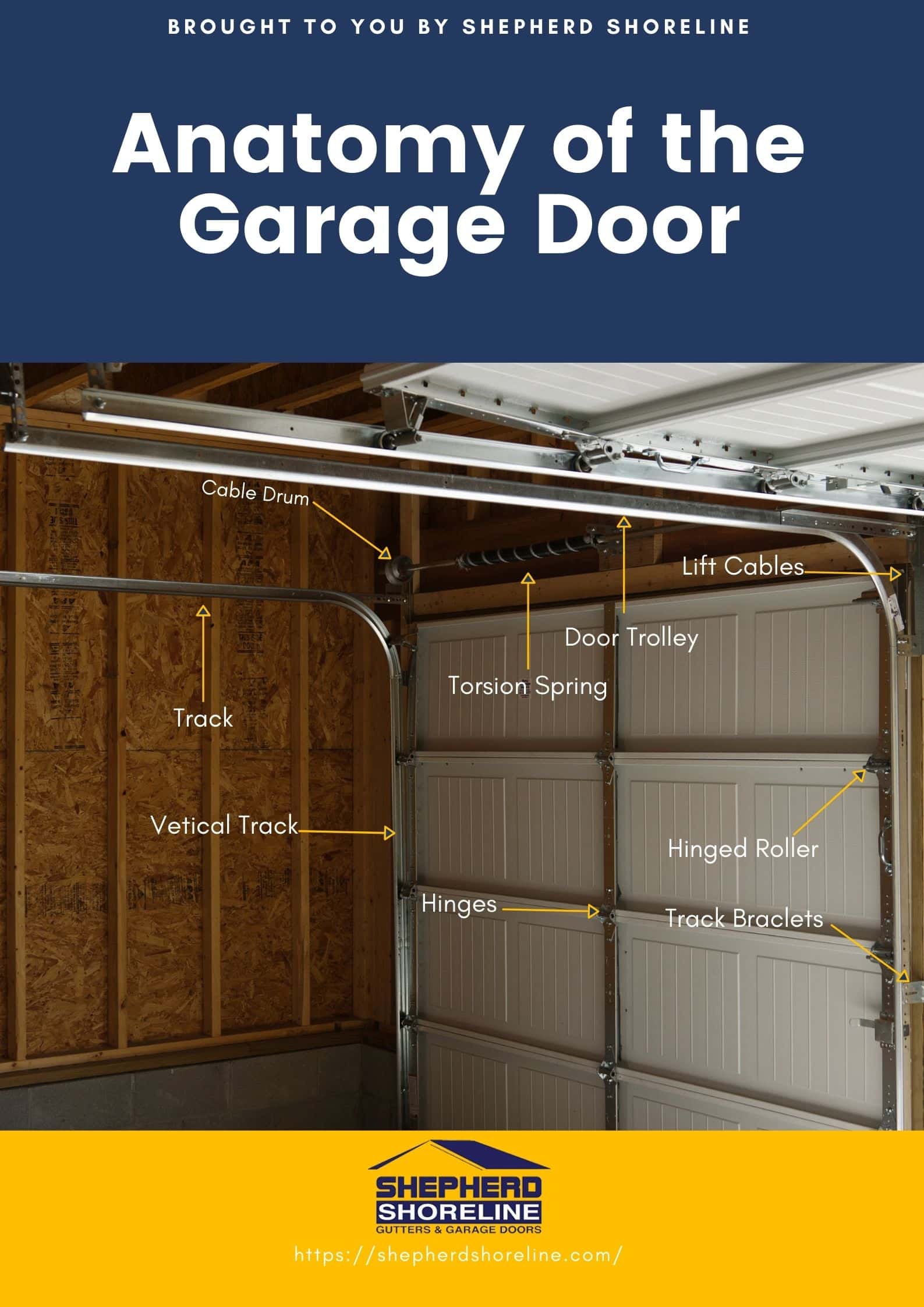
Garage doors have come a long way from the heavy, swinging carriage doors of the past. What once required muscle and effort to open has now evolved into sleek, innovative systems that combine style, safety, and convenience. Modern garage doors not only protect your vehicles and belongings, but also add curb appeal and value to your property.
- Popular Types of Garage Doors
- Anatomy of a Garage Door
- Choosing the Right Door for Your Muskegon Home or Business
- When to Call for Expert Installation and Repair
Understanding garage door styles and their anatomy can help you make an informed decision that fits your home or business. The right door balances function with design, and professional garage door installation in Muskegon guarantees proper setup, long-lasting performance, and peace of mind. Let’s explore the different types of garage doors and see which one fits your needs best.
Popular Types of Garage Doors
Choosing the right garage door starts with knowing the different styles available. Each type has its own unique operation, look, and best use. Here are the most common options:
Roll-Up Garage Doors
Roll-up doors are made from narrow steel slats that roll into a coil above the opening. These doors are space-saving, extremely durable, and built for security. While commonly used in warehouses and commercial settings, roll-up garage doors are great for residential storage spaces or detached garages where overhead room is limited.
Sectional Garage Doors
Sectional garage doors, the most popular choice for residential homes, are made of panel sections connected with hinges. As the door opens or closes, wheels at the edge of each panel roll inside a vertical track. These doors operate smoothly, offer excellent insulation options, and come in a wide range of designs to complement the exterior of your home.
Side-Sliding Garage Doors
Instead of moving upward, side-sliding doors run along tracks on the floor and ceiling, sliding neatly to one side. These doors operate quietly and are perfect for garages with low ceilings or unusual layouts. Side-sliding garage doors make partial openings easy, giving you convenient access without lifting the entire door.
Sliding Barn-Style Garage Doors
For a rustic, modern farmhouse aesthetic, sliding barn-style doors are a trendy and functional option. These doors operate with a single or double panel that slides along a track mounted on the exterior of the garage. Sliding barn-style doors can make a strong design statement and add character to your Muskegon home or outbuilding.
Side-Hinged Garage Doors
As one of the oldest garage door styles, side-hinged doors swing outward, similar to traditional double doors. These doors bring a countryside charm and feel while remaining functional. Today, side-hinged garage doors can even be automated, blending classic design with modern convenience.
Tilt-Up Garage Doors
Tilt-up doors consist of a single solid panel that tilts outward and upward to open. These doors offer more style options since the panel can be customized as one large piece, but require more clearance space in front of the garage to operate, and are typically considered less safe in high-wind areas due to the large single-panel design.
Anatomy of a Garage Door
When you know the basic parts of your garage door, it’s easier to spot problems early and keep your system running smoothly. Here are the main components you should be familiar with:
Panels
These are the visible sections of your garage door. Most residential doors are made of multiple horizontal panels that bend as the door opens and closes. Panels can be made from steel, aluminum, wood, or composite materials, often designed to match the exterior style of your home.
Torsion Spring
The torsion spring helps lift the heavy weight of the garage door. Mounted above the door, it stores energy when the door closes and releases it when you open it. These springs are under high tension, so if one breaks or wears out, it’s best to leave replacement to professionals.
Tracks
Tracks guide the movement of your door. Vertical tracks run up the side of the garage opening, while horizontal tracks extend along the ceiling. These components keep the door aligned and ensure smooth operation. Dents or misalignment in the tracks can cause the door to jam or become noisy.
Locks and Latches
Manual locks and latches offer additional security for garage doors, especially for properties without automatic openers. While not always used in modern systems with smart garage door openers, such components can be a valuable backup, especially in case of power outages.
Weather-Stripping
Weather-stripping seals the edges of your garage door, helping to block drafts, moisture, and debris. Moreover, it protects against pests and reduces energy loss. Regular inspection and replacement of worn weather-stripping can help keep your garage dry and insulated.
Drive Unit
The drive unit powers the opener mechanism. It can be belt-driven, chain-driven, or screw-driven, each with its own benefits. Quieter belt drives are great for attached garages, while chain drives offer strength and durability for heavier doors.
Opener Unit
The opener system allows garage door automation. Most come with handheld remotes, wall-mounted keypads, and now even smartphone connectivity for added convenience and control. Modern systems may include battery backup in case of outages.
Emergency Release Cord
Usually marked with a red handle, the emergency release cord disconnects the door from the automatic opener so you can open or close it manually. It’s vital during a power outage or malfunction and should be tested occasionally to ensure it functions correctly.
Safety Sensors
Located at the bottom sides of the door, safety sensors detect motion and prevent the door from closing if something is in the way. These sensors are an essential safety feature, especially for families with kids or pets, and must be kept clean and aligned for effective performance.
Choosing the Right Door for Your Muskegon Home or Business
In Muskegon, you’re often dealing with lake effect snow, heavy rain, and seasonal humidity, and your garage door needs to stand up to the ever-changing weather while keeping your space secure and functional. Here are some key considerations to keep in mind when looking for a new garage door:
- Climate Considerations
A garage door with proper insulation helps protect against moisture and temperature swings. Insulated steel doors or composite materials work well for both durability and energy efficiency. Weather-resistant coatings and seals are a must to prevent rust and water damage.
- Space and Layout
Some garage door styles are better suited for tight or unique layouts. For example, roll-up or side-sliding doors work well in garages where ceiling or back wall space is limited. Sectional doors are ideal for most standard homes, while tilt-up or barn-style doors need extra clearance in front.
- Security and Durability
Opt for heavy-duty materials, secure locking mechanisms, and reinforced hardware for your Muskegon garage door if security is a top priority. Modern openers with rolling-code technology or smart access controls add another layer of protection, especially in commercial settings.
- Aesthetics and Curb Appeal
A garage door often takes up a large portion of the exterior of your home. Pick a style that complements the architecture of your property to boost curb appeal. Whether you prefer a classic carriage look, sleek modern panels, or a rustic wood finish, the options are nearly endless.
Professional garage door installation in Muskegon ensures you get the right fit for your property. Experts can recommend the best styles and materials, set up the system safely, and make sure everything operates efficiently from day one.
When to Call for Expert Installation and Repair
While it might be tempting to tackle garage door installation or repairs on your own, it’s not something you should DIY. Garage door systems involve heavy materials, high-tension torsion springs, and electrical components that can be dangerous if handled improperly. A simple mistake can lead to serious injury or costly damage, not to mention the risk of installing something incorrectly and having it fail later on.
If you’re looking for safe, reliable, and long-lasting garage door installation in Muskegon, turn to the trusted experts at Shepherd Shoreline. With decades of experience, our team can help you choose the right door, set it up properly, and keep it working smoothly year after year. Contact us today at (231) 780-2847 or here to schedule your garage door installation, repair, or maintenance service.


